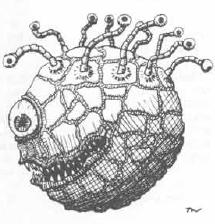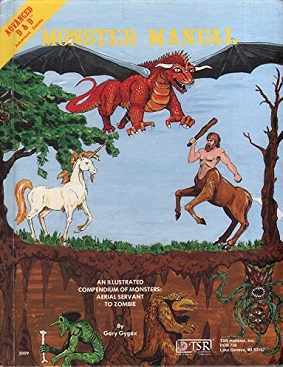
The beholder is a fictional monster in the Dungeons & Dragons fantasy role-playing game. Its appearance is that of a floating orb of flesh with a large mouth, single central eye, and many smaller eyestalks on top with powerful magical abilities.
The planes of the Dungeons & Dragons roleplaying game constitute the multiverse in which the game takes place.

An ettercap is a race of bestial spider-men aberrations in the Dungeons & Dragons fantasy roleplaying game.

In the Dungeons & Dragons fantasy role-playing game, xorn are outsiders from the Elemental Plane of Earth.

In the Dungeons & Dragons fantasy roleplaying game, the cloaker is a type of fictional monster portrayed as being able to disguise its body to resemble a cloak when at rest. The cloaker pacifies victims with an eerie moan, and engulfs its prey within its body to help it eat the prey. The cloaker was introduced in the first edition Advanced Dungeons & Dragons game adventure module, Secret of the Slavers' Stockade as an ally to the adventure's antagonists. The cloaker subsequently appeared in the first edition Monster Manual II, and then appeared several times in the game's second edition, third edition, fourth edition and fifth edition.
In the Dungeons & Dragons fantasy role-playing game, undead is a classification of monsters that can be encountered by player characters. Undead creatures are most often once-living creatures, which have been animated by spiritual or supernatural forces.

In the Dungeons & Dragons fantasy role-playing game, an elemental is a type of creature. Elemental creatures are composed of one of the four classical elementals of air, earth, fire, or water.

In the Dungeons & Dragons fantasy role-playing game, hags are female, witchlike creatures known for their cruelty and repulsiveness. They use their magic to sow discord and to spread corruption. Many hag variations have appeared in the numerous editions of Dungeons & Dragons since their first appearance in a 1975 rules supplement.
In the Dungeons and Dragons fantasy role-playing game a delver is a gigantic, stony, slug-like aberration. The creature resembles an enormous cross between a centipede and a slug. It is roughly 15 feet long, 12 feet tall, and 10 feet wide, and big and bulbous. It is a gritty brown color, and has a huge stony mouth and slits for eyes. Coming from its shoulders are giant, spongy, flipper-like arms, each of which ends in six black digging nails.
In the Dungeons & Dragons fantasy role-playing game, a phase spider is a magical beast akin to a predatorial version of the ethereal filcher.
In the Dungeons & Dragons fantasy role-playing game, an ethereal marauder is a magical beast with abilities similar to ethereal filchers and phase spiders.
In the Dungeons & Dragons fantasy role-playing game, the howler is an outsider from planes dominated by evil forces, e.g... the lower planes. It resembles a furless monkey crossed with a sickly dog, and has a vaguely human-like face. It is grey in color, with the slightest hints of violet. For no apparent reason, its shoulders jut sharply up in ugly extremities. Growing along its back and from its front legs, are sharp quills.

In the Dungeons & Dragons fantasy role-playing game, the leucrotta is a magical beast.
Within the world of the Dungeons & Dragons fantasy role-playing game, construct is a type of creature, or "creature type". Constructs are either animated objects, or any artificially constructed creature.
The astral dreadnought is an outsider in the Dungeons & Dragons fantasy role-playing game.
The Dungeons & Dragons fantasy role-playing game contains many monsters that are similar or related to dragons but which are not "true dragons", which are dragons that grow stronger with age. These can be magical beasts, half-dragons, creatures with more distant dragon ancestry, races descending from actual dragons, or creatures of other types, which resemble dragons. Alternatively, they could have the dragon type or keyword, but not be true dragons, or they could have the "dragonblood" subtype in the 3rd edition of Dungeons & Dragons.
The Dungeons & Dragons fantasy role-playing game contains many plant creatures that are composed of vegetable material, but unlike normal plants these monsters may be carnivorous, intelligent, mobile, or any combination of the three. In the 3rd edition of Dungeons & Dragons, plant creatures have the plant "creature type".
Metallic dragon is a classification of dragon found in the role playing game Dungeons & Dragons. In this setting metallic dragons are of good alignment. Bahamut is the deity of good-aligned dragons and metallic dragons, and currently the only known Platinum dragon in existence. Metallic dragons have played a large role in D&D's various monster compilation books, and for most of the game's history five main types - brass, copper, bronze, silver, and gold - were presented as roughly analogous to the five types of chromatic dragons. The fourth edition of the game's second Monster Manual substituted iron and adamantine dragons for brass and bronze, and released the latter dragons in a later book alongside cobalt, mercury, mithral, orium, and steel dragons.







